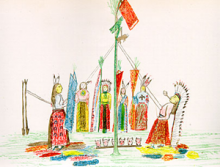Article
Kado is the term for the Kiowa Sun Dance, a ritual ceremony performed across the Great Plains by various tribes, including the Arapaho, Blackfoot, Comanche,Kiowa, Sioux, Ute, and more recently the Navajo. The primary purpose for the ceremony is to perpetuate the cycle of life by symbolically defeating spiritual and physical challenges during the course of the ritual, which can last as many as four days. The ceremony is also an expression of gratefulness to the creator for the generosity enjoyed during the previous year. The ceremony is one of reciprocity at many levels: between dancers and their instructors, between the participants and the dancers, and between the celebrants and the broader universe.
Sun dance" painting by James Mooney, from The Ghost-dance Religion and the Sioux Outbreak of 1890 in the Annual Report of the Bureau of Ethnology to the Secretary of the Smithsonian Institution, 1896".
Manuscripts
References
"Mooney, James
1896 The Ghost-dance Religion and the Sioux Outbreak of 1890. Annual Report of the Bureau of Ethnology to the Secretary of the Smithsonian Institution. Washington, D.C.: Government Printing Office."
"Pritzker, Barry M.
N.d. Sun Dance. The American Mosaic: The American Indian Experience. http://americanindian2.abc-clio.com/Search/Display/1463426?terms=sun+da…, accessed December 16, 2014."
"Scott, Hugh Lenox
1911 Notes on the Kado, or Sun Dance of the Kiowas. American Anthropologist 13(3):345-379."

